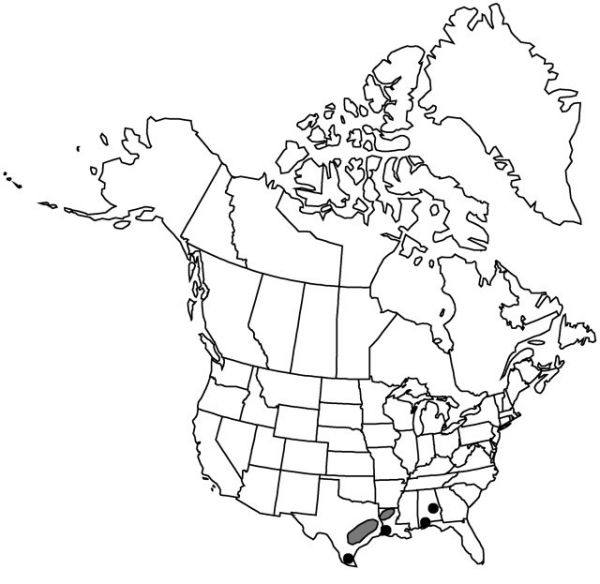Habranthus tubispathus
Pl. Life 7: 42. 1951.
Leaf blade dull green, to 4 mm wide. Inflorescence 1-flowered; spathe 1.9–3.1 cm. Flower: perianth 2.1–3.1 cm, tube tinged green, ca. 0.2 cm, distinct portions of tepals somewhat spreading, not reflexed, bright yellow or orangish yellow, sometimes tinged burgundy abaxially, color deepening proximally; filaments 0.8–1.8 cm; anthers (2–)4–5 mm; style 1.8–2 cm; stigma equaling or rarely extending more than 1 mm beyond anthers; pedicel (2–)3.3–4.5(–5.6) mm, exceeding spathe. 2n = 24.
Phenology: Flowering summer–early fall (Jun–Oct).
Habitat: Grasslands, prairies, disturbed areas
Elevation: 0–300 m
Distribution

Ala., Fla., La., Tex., South America.
Discussion
In addition to positional differences in the stamens, the trifid, linear stigma of Habranthus tubispathus distinguishes it in its North American range from late summer- and fall-blooming, yellow-flowered, sympatric Zephyranthes species, which have capitate stigmas.
It is not clear whether Habranthus tubispathus is native to North America or was introduced, but it is a disjunct species also found in Argentina, Brazil, central and southern Chile, and southern Uruguay. Another such species is Cienfuegosia drummondii (A. Gray) Lewton (Malvaceae), which occurs in northern Argentina, southernmost Brazil, Paraguay, and southern Texas. These taxa are two of a small group of bicentric species showing disjunct distributions between eastern North America and temperate South America (P. A. Fryxell 1967). All are perennial and fully self-compatible, with a high reproductive potential, so the establishment of a single individual could accomplish disjunction. However, H. tubispathus lacks what all the others share: an impermeable seed coat that allows for a degree of dormancy and longevity.
In the 1930s, Harold H. Hume (J. R. Sealy 1937) suggested that Spanish missionaries had introduced Habranthus tubispathus to Texas around 1700. W. C. Holmes and C. J. Wells (1980) have recently supported this idea. Nevertheless, this means of distribution is questionable since, as W. S. Flory (1938) pointed out, the records indicate that Spaniards out of Mexico founded the Texas missions, and H. tubispathus is not found in Mexico. A. R. Diamond et al. (1998) reported historical evidence for the introduction of H. tubispathus into Alabama in the late 1800s by seeds being sent from Texas. A similar mechanism could have introduced the species to Texas from South America.
Selected References
None.
